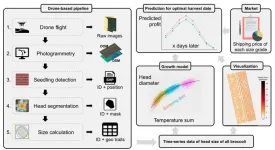(Press-News.org) Residing in a more walkable neighborhood protects against the risk of overall obesity-related cancers in women, specifically postmenopausal breast cancer, but also ovarian cancer, endometrial cancer, and multiple myeloma, according to a new study by Columbia University Mailman School of Public Health and NYU Grossman School of Medicine. Obesity has been linked to increased risk for 13 types of cancer in women, and physical activity, independent of body size, lowers risk for some of these cancers. Neighborhood walkability is a set of urban design features that promotes pedestrian activity, supports overall physical activity and is associated with lower body mass index. However, until now long-term studies of neighborhood walkability and risk for obesity-related cancer were limited. The findings are published in the journal Environmental Health Perspectives.
Women who resided in neighborhoods with higher walkability levels, as measured by average destination accessibility and population density over approximately 24 years of follow-up, had lower risk of obesity-related cancers, particularly postmenopausal breast cancer. However, moderate protective associations were also found for endometrial cancer, ovarian cancer, and multiple myeloma. Women in who had lived in areas with the highest levels of neighborhood walkability (the top 25 percent of walkability) had a 26 percent lower risk of obesity-related cancers compared to those who lived in neighborhoods in the lowest 25th percent of walkability.
“These results contribute to the growing evidence of how urban design affects the health and wellbeing in aging populations,” said Andrew Rundle, DrPH, professor of epidemiology at Columbia Mailman School. Individual-level interventions to increase physical activity and reduce obesity are costly and often have only short-term effects, according to Rundle and colleagues. “However, urban design can create a context that promotes walking, increases overall physical activity, and reduce car-dependency, which could lead to subsequent improvements in preventing diseases attributed to unhealthy weight,” Rundle observed.
“We further observed that the association between high neighborhood walkability and lower risk of overall obesity-related cancers was stronger for women living in neighborhoods with higher levels of poverty” said Sandra India-Aldana, Ph.D., Icahn School of Medicine at Mount Sinai, and lead author. “These findings suggest that neighborhood social and economic environments are also relevant to risk of developing obesity-related cancers.”
The researchers studied 14,274 women between the ages of 34 and 65 and recruited at a mammography screening center in NYC between 1985 and 1991 and followed them over nearly three decades. They measured neighborhood walkability in the participant’s residential Census-tract throughout follow-up and assessed the association between neighborhood walkability and risk of overall and site-specific obesity-related cancers including postmenopausal breast cancer, ovarian cancer, endometrial cancer, and multiple myeloma. Of the total number of women studied, 18% had a first obesity-related cancer by the end of 2016.The most common cancer was postmenopausal breast cancer at 53%, followed by colorectal cancer at 14%, and endometrial cancer at 12%.
“Our study is unique in that the long-term follow-up allowed us to study effects of walkability with potential long latency periods of cancer and we were able to measure neighborhood walkability as the participants moved residences around the country during follow-up” said co-author Yu Chen Ph.D., NYU Grossman School of Medicine.
Other co-authors are Tess Clendenen, Yelena Afanasyeva, Karen Koenig, and Anne Zeleniuch-Jacquotte, NYU Grossman School of Medicine; Mengling Liu and Lorna Thorpe, NYU Grossman School of Medicine and NYU Langone Health; James W. Quinn, Columbia Mailman School of Public Health; and Kathryn Neckerman, Columbia University Population Research Center.
The study was supported by U.S. NIH grants UM1CA182934-01A1, UM1CA182934-05-S1, P30CA016087, P30ES000260, 1R01AG049970, and 3R01AG049970.
Columbia University Mailman School of Public Health
Founded in 1922, the Columbia University Mailman School of Public Health pursues an agenda of research, education, and service to address the critical and complex public health issues affecting New Yorkers, the nation and the world. The Columbia Mailman School is the fourth largest recipient of NIH grants among schools of public health. Its nearly 300 multi-disciplinary faculty members work in more than 100 countries around the world, addressing such issues as preventing infectious and chronic diseases, environmental health, maternal and child health, health policy, climate change and health, and public health preparedness. It is a leader in public health education with more than 1,300 graduate students from 55 nations pursuing a variety of master’s and doctoral degree programs. The Columbia Mailman School is also home to numerous world-renowned research centers, including ICAP and the Center for Infection and Immunity. For more information, please visit www.publichealth.columbia.edu
END
Women living in more walkable neighborhoods have lower rates of obesity-related cancers
2023-10-04
ELSE PRESS RELEASES FROM THIS DATE:
Extreme fires and heavy rainfall driving platypuses from their homes
2023-10-04
Australia’s emerging pattern of severe mega bushfires and heavy rainfall may be driving platypuses from their homes, a new study by University of Melbourne researchers has shown.
Analysis of platypus DNA in rivers and creek water samples collected before and after the Black Summer 2019-2020 megafires suggest Australia’s beloved semi-aquatic monotremes might be abandoning severely bushfire-affected areas for up to 18 months after a fire, especially if heavy rainfall has followed the fire.
The study uses the recent technique of environmental DNA sampling, where animal DNA is collected from water, soil, air, or snow ...
Antigen testing can reduce, but not eliminate, the risk of COVID-19 clusters according to mathematical model
2023-10-04
A research group has created a new model to calculate the probability of the occurrence of localized clusters caused by novel coronavirus infections. Led by Shingo Iwami at Nagoya University with collaborators in the United Kingdom and South Korea model, they revealed that screening of infected persons by antigen testing is effective in significantly reducing the probability of cluster occurrence. However, their findings also suggest that it is not sufficient to prevent clusters caused by highly infectious mutant strains, such as Omicron.
With the availability of COVID-19 vaccines and population immunity, countries around the world are seeking to ...
AI drones to help farmers optimize vegetable yields
2023-10-04
For reasons of food security and economic incentive, farmers continuously seek to maximize their marketable crop yields. As plants grow inconsistently, at the time of harvesting, there will inevitably be variations in quality and size of individual crops. Finding the optimal time to harvest is therefore a priority for farmers. A new approach making heavy use of drones and artificial intelligence demonstrably improves this estimation by carefully and accurately analyzing individual crops to assess their likely growth characteristics.
Some optimistic science fiction stories talk about a post-scarcity future, where human needs are catered for and hard labor ...
Wastewater detects signs of antimicrobial resistance in aged care
2023-10-04
A new study published today, analysing wastewater samples from several aged care and retirement homes in Adelaide, has uncovered worrying signs of antimicrobial resistance (AMR) in at least one facility.
High levels of bacterial resistance against three common antibiotics – ceftazidime, cefepime and ciprofloxacin – were identified in one aged care residential home. A second facility recorded above average levels of antimicrobial resistance to gentamicin, putting residents’ health at risk.
The listed antibiotics are used to treat a variety of bacterial infections, including pneumonia, ...
Unique voice print in parrots
2023-10-04
Parrots are exceptional talkers. They can learn new sounds during their entire lives, amassing an almost unlimited vocal repertoire. At the same time, parrots produce calls so they can be individually recognized by members of their flock—raising the question of how their calls can be very variable while also uniquely identifiable. A study on monk parakeets conducted by the Max Planck Institute of Animal Behavior and Museu de Ciències Naturals de Barcelona might have the answer: individuals have a unique tone of voice, known as a voice print, similar to that in humans. This finding in a wild parrot raises the possibility that a voice print ...
Potential genetic screening for aggressive melanoma
2023-10-04
Researchers from The University of Queensland and The Alfred hospital in Melbourne have identified gene variants which may contribute to people being at higher risk for nodular melanoma.
Dr Mitchell Stark from UQ’s Frazer Institute said nodular melanoma only accounts for around 14 per cent of invasive melanoma cases, but the aggressive subtype is the largest contributor to melanoma deaths.
“Melanoma is highly curable by surgery when diagnosed early, but nodular melanoma is often detected ...
Striking inequalities in provision of life-saving heart valve replacement in England
2023-10-04
Public health initiatives to understand and tackle these inequalities should be prioritised, say the researchers.
The aortic valve keeps blood flowing from the heart's lower left chamber (left ventricle) to the aorta—the main artery bringing blood from the heart to the body. Aortic stenosis occurs when the aortic valve narrows as a result of calcium build-up, impeding normal blood flow. This causes shortness of breath, light headedness, and chest pain (angina).
Aortic valve replacement (AVR) not only relieves these symptoms, but increases life expectancy, and improves quality of life, say the researchers, adding that up to 1 in 4 of those with severe or very severe aortic stenosis ...
Critical data gaps on doctor assisted deaths in Oregon amid rise in participants
2023-10-04
Information on clinical complications is often missing, while key information on the factors behind medical decision-making, the effectiveness of the lethal drugs used, and the extent of palliative care support isn’t even collected, reveals the review.
Physician assisted suicide as it’s formally known has been legal in the US state of Oregon since 1997 under the Death with Dignity Act.
The legislation allows terminally ill residents over the age of 18 to hasten their death by taking lethal drugs prescribed by a doctor, providing they are capable of making and communicating healthcare ...
New robot could help diagnose breast cancer early
2023-10-04
A device has been created that could carry out Clinical Breast Examinations (CBE).
The manipulator, designed by a team at the University of Bristol and based at the Bristol Robotics Laboratory, is able to apply very specific forces over a range similar to forces used by human examiners and can detect lumps using sensor technology at larger depths than before.
This could revolutionise how women monitor their breast health by giving them access to safe electronic CBEs, located in easily accessible places, such as pharmacies and health centres, which provide accurate results.
Precision, repeatability and ...
A prehistoric cosmic airburst preceded the advent of agriculture in the Levant
2023-10-04
Agriculture in Syria started with a bang 12,800 years ago as a fragmented comet slammed into the Earth’s atmosphere. The explosion and subsequent environmental changes forced hunter-gatherers in the prehistoric settlement of Abu Hureyra to adopt agricultural practices to boost their chances for survival.
That’s the assertion made by an international group of scientists in one of four related research papers, all appearing in the journal Science Open: Airbursts and Cratering Impacts. The papers ...



